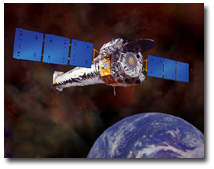Disclaimer: This material is being kept online for historical purposes. Though accurate at the time of publication, it is no longer being updated. The page may contain broken links or outdated information, and parts may not function in current web browsers. Visit chandra.si.edu for current information.
When an Extra Second Matters
February 28, 2006 :: |
| Spacecraft Illustration with Earth Background |
As the new year of 2006 approached, many news stories noted that an extra second would be added to the world's clocks at the stroke of midnight, December 31st. For most, this was a quirky factoid to mention during the night's festivities. But, for many people at Chandra's Operation Control Center (OCC) and other places, it added up to a lot of time.
A "leap second" is a one-second adjustment that is used to keep civil time aligned with the Earth's rotation. Such an adjustment is necessary because atomic clocks, which are based on a frequency of cesium atoms, are incredibly stable and are used to define the duration of a second. The Earth's rotation, on the other hand, is not as stable and has been shown to slow down by tiny amounts.
 |
| Control Center |
Waiting for the crowds to clear after the 2004 Independence Day fireworks, the OCC's Bill Davis stopped by his Cambridge office and checked his email. There, he found a bulletin waiting for him from the IERS announcing the intention to add a leap second to 2005. After forwarding the bulletin to the various Chandra operations teams, Bill Davis entered a request to respond to the upcoming leap second just 10 days later.
Why go through all of this effort for just one second? The answer is that each X-ray photon is given a detection time by the spacecraft and subsequent ground processing. Some observations have stringent time accuracy requirements, 20 microseconds (0.00002 seconds) in some cases.
 |
| Chandra and the Deep Space Network |
Previous leap seconds had been added every year or two, sometime twice a year. The unusual trait of the end-of-2005 leap second was that the previous leap second had been 7 year before, in 1998, the year before Chandra's launch. The 2005 leap second would be the first of Chandra's mission. To share information with other space-based missions, which would also be dealing with the issue, Bill Davis joined the Leap Second Working Group at NASA's Goddard Space Flight Center (GSFC) in Greenbelt, Md. Having worked on several space missions at GSFC before joining the Chandra project, Bill had an idea which aspects of Chandra's software systems would be most vulnerable to a leap second: the software that handles the calibration of Chandra's clock and the software that determines its position.
 |
| Operations Control Center, 2001 Training Simulation |
Eventually, eight different Chandra systems were evaluated, both those on the ground at the OCC and others aboard the spacecraft itself. Ultimately, a simple change to the telemetry data removed the effect of the leap second for the calibration clock on Chandra. This allowed the clock on-board Chandra to sync up with the existing software that was not built to take leap seconds into account.
 |
| OCC Exterior |
All of the efforts undertaken by the staff at the OCC were entirely successful. Their planning and execution prevented any precious data loss for NASA's premier X-ray telescope. Thanks to them, the 2005 leap second passed as quietly for Chandra as it did for the rest of the New Year's revelers.
Many thanks go to George Leussis of the OCC, Ian and Janet Evans of the CXCDS, and Ken Gage and Sabina Bucher of the Flight Operations Team (FOT). This article was written by Bill Davis and Jeff Holmes of the CXC OCC and edited by the CXC EPO group.
Disclaimer: This material is being kept online for historical purposes. Though accurate at the time of publication, it is no longer being updated. The page may contain broken links or outdated information, and parts may not function in current web browsers. Visit chandra.si.edu for current information.




